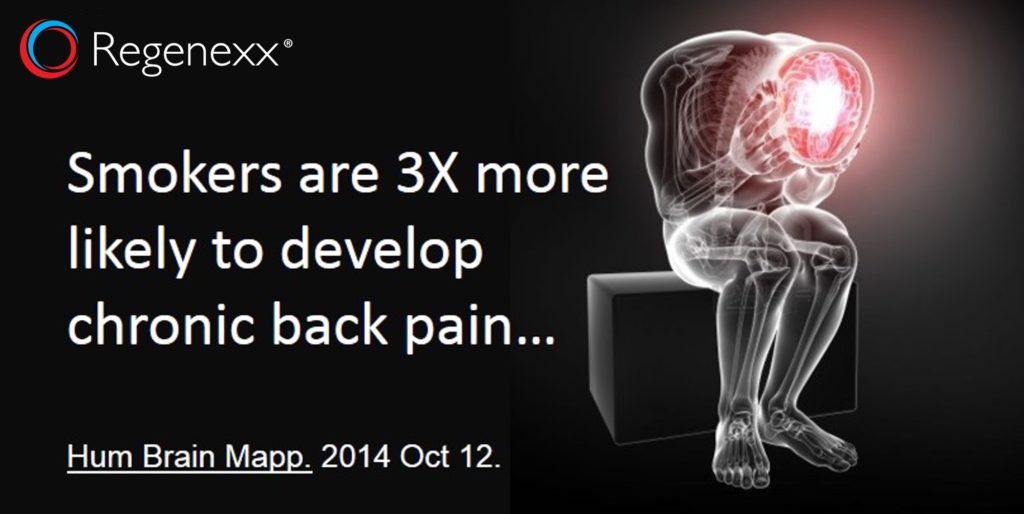Smoking Increases the Likelihood of Chronic Back Pain
Smoking and low back pain are not subjects that we would usually associate, and the concept that smoking increases risk of chronic pain is a novel a development. Our understanding of the how the brain reacts to pain has exploded in the last decade due to advances in imaging technology. Recently, a researcher at Northwestern added another chapter in the book of pain and the brain. In their recent study, patients who smoked cigarettes were 3 times as likely to develop chronic low back pain due to the shared reward centers of the brain that are activated by both smoking and chronic pain!
The Apkarian lab has an apt byline on it’s web-page-“Pain and Passions”. This is the same group that I stumbled upon in 2004 when they published a paper on how chronic low back pain caused atrophy of key areas of the brain that could be observed on MRI imaging. In particular, the thalmus (the ancient pain center of the brain that receives aching type pain) got smaller in patients with chronic pain. While this paper should have turned the traditional pain management world on it’s head which at the time was struggling to make any sense out of how to treat chronic pain (and doing a very poor job of it in general), it was barely noticed. However, it’s great to see that Apkarian’s research group has flourished and has moved on to functional brain imaging in an attempt to understand some of these dramatic and ground breaking discoveries of the early 2000s.
Functional brain imaging looks at which areas of the brain are active when the patient is in pain. Contrast that to more traditional MRI that can only show us the overall structure and size of an area. In the most recent study, the researchers imaged more than a hundred patients, focusing in on brain activity of the nucleus accumbens (NA). This spot in the brain has a significant role in the processing of motivation, reward, pleasure, and learning that involves reinforcement. As a result, it’s thought to play a significant role in addiction. It also encodes new motor programs or movement patterns.
When the researchers compared the activity of how the NA shuttled information to the higher centers of the brain in smokers versus non-smokers and those who developed chronic low back pain versus those patients where the condition resolved, they found that the strength of the connection was better in smokers and patients with low back pain. In addition, the strength of the connection weakened in those patients who had quit smoking or who never developed chronic back pain. Based on this and other data, they concluded that patients who smoked had three times as high a likelihood to go onto develop chronic back pain which was mediated by this brain connection.
How can we interpret this new information? While it would be tempting to say that patients are psychologically addicted to pain, this study actually suggests that they are physically addicted. It’s important to note that the NA is part of the dopamine reward system. So it may make sense that the development of chronic pain has a reward tied to it in the brain, as there are few other physical rewards for being in pain for long periods while the body tries to heal a big injury. Meaning that if it were 10,000 years ago, the downside of being in pain for a long-time are numerous, so it’s not surprising that the brain developed to “trick” us with a reward system. This accomplishes the goal of keeping the body inactive longer to provide a passable chance of mending a slow healing trauma.
The upshot? Chronic pain changes your brain in very measurable ways. If you’re mind isn’t blown buy the fact that pain centers in the brain get physically smaller in chronic pain patients, then maybe it will be twisted by the data showing that the part of the brain that controls addiction that’s linked to why you can’t quit smoking is also linked to the development of chronic pain. In addition, another study out of the Apkarian lab this month also ties risky financial behavior in back pain patients to the same NA system. What other mind benders are around the corner?

NOTE: This blog post provides general information to help the reader better understand regenerative medicine, musculoskeletal health, and related subjects. All content provided in this blog, website, or any linked materials, including text, graphics, images, patient profiles, outcomes, and information, are not intended and should not be considered or used as a substitute for medical advice, diagnosis, or treatment. Please always consult with a professional and certified healthcare provider to discuss if a treatment is right for you.

